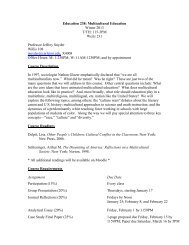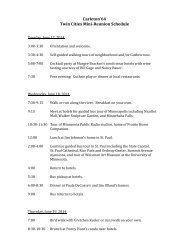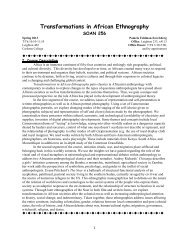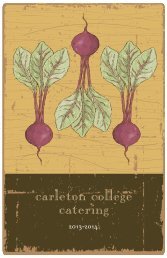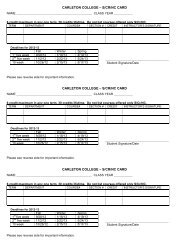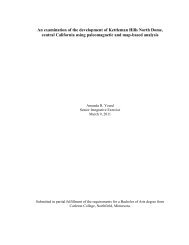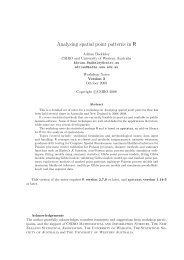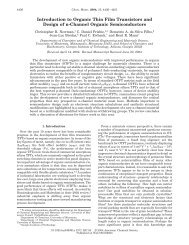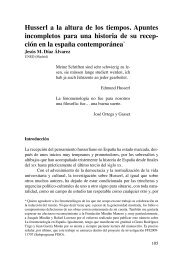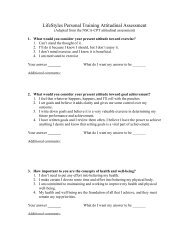babababababababababababababab the druid ... - Carleton College
babababababababababababababab the druid ... - Carleton College
babababababababababababababab the druid ... - Carleton College
Create successful ePaper yourself
Turn your PDF publications into a flip-book with our unique Google optimized e-Paper software.
Spiritualism, Scientology, Process, Ceremonial Magick, etc. The resulting<br />
system, now calling itself “<strong>the</strong> Druidic Craft of <strong>the</strong> Wise,”<br />
bears no resemblance to any system of Druidism practiced in Europe<br />
or North America, now or in <strong>the</strong> past. Nei<strong>the</strong>r does it resemble<br />
Neopagan Witchcraft very much, except for a few items obviously<br />
borrowed from easily available published sources. However, because<br />
<strong>the</strong> name “Druidic” is attached to Taylor’s teachings, it would be<br />
wise to give a short account of <strong>the</strong>m.<br />
The DCW is a strictly authoritarian and patriarchal mono<strong>the</strong>istic<br />
religion. The deity is called “The Fa<strong>the</strong>r,” and no references are made<br />
to female deities at all. The word of Taylor is law—no criticisms may<br />
be voiced and no outside religious study or practice is allowed. All<br />
competing religious groups are termed fraudulent (including <strong>the</strong><br />
Neopagan Witches Taylor recommends in writing but forbids in<br />
practice) and his attitude towards <strong>the</strong>m is one of complete hostility.<br />
Private lessons at his farm in Arkansas, as well as correspondence<br />
lessons are available, however (judging from <strong>the</strong> copies of <strong>the</strong> correspondence<br />
materials seen by this writer) <strong>the</strong>y are of abysmally poor<br />
quality.<br />
Part of <strong>the</strong> initiation ceremony (done by a priest/ess claiming to<br />
be “of <strong>the</strong> Order of Melchizadeck”) involved <strong>the</strong> placing of a “Spirit<br />
Guide” on <strong>the</strong> back of <strong>the</strong> neck of <strong>the</strong> initiate. According to<br />
exmembers, this is actually a vampire or artificial elemental, used to<br />
psychically bond to <strong>the</strong> group toge<strong>the</strong>r and to provide a source of<br />
psychic energy for Taylor and his friends. Many elements from <strong>the</strong><br />
psychic technology of <strong>the</strong> Process and Scientology are evident, including<br />
<strong>the</strong> major technique of “spiritual enlightening” a student by<br />
destroying <strong>the</strong>ir old, non-magical , personality and building <strong>the</strong>m a<br />
brand new personality that is magical—and does exactly as it’s told.<br />
Through out <strong>the</strong> course of training, students are given many secrecy<br />
oaths and almost no explanations whatever of what is going on.<br />
Taylor apparently feels that, as Guru, he has a right to manipulate<br />
his students “for <strong>the</strong>ir own good.”<br />
A number of very harsh and alarming accusations about Taylor<br />
and his activities have been made over <strong>the</strong> years, but so far no evidence<br />
that would stand up in a court of law has been produced. The<br />
psychic result of his training system, for those who stick with it, are<br />
obvious even to little-old-lady-tea-readers; classic examples of <strong>the</strong> “sleazysatan-scientologist-junkie-vibe”<br />
so familiar to observers of <strong>the</strong> less<br />
savory fringes of <strong>the</strong> occult community.<br />
Let me reiterate that <strong>the</strong> “Druidic Craft of <strong>the</strong> Wise” bears no<br />
resemblance to or connections with any of <strong>the</strong> Masonic Druid groups<br />
in England and America, nor with any of <strong>the</strong> Branches of <strong>the</strong> Reformed<br />
Druid movements in North America, save one. Several Covens<br />
are currently breaking away from Taylor and <strong>the</strong>y have expressed<br />
interest in <strong>the</strong> Reformed Druid movements [possibly <strong>the</strong> Celtic <strong>College</strong><br />
of Reformed Druidic Wicca?—Scharding]. Since several Covens<br />
have broken away in <strong>the</strong> past and joined various Neopagan Witchcraft<br />
groups, this is not an impossible task.<br />
Readers are advised to stay as far away as possible from Taylor and<br />
his followers, however. There are plenty of legitimate Druidic and<br />
Craft groups around to choose from.<br />
321<br />
Neopagan Druidism<br />
by Isaac Bonewits<br />
Here is <strong>the</strong> article from Vol. 2, Issue 6 of Pentalpha/Druid Chronicler<br />
by Isaac Bonewits as it was printed in 1979. At <strong>the</strong> time of writing this<br />
article Isaac was essentially on a sabbatical away from Reformed Druidism<br />
and doing intensive study of ancient Indo-European religions. Much<br />
of Isaac’s materials of this time period may be interpreted as indicative of<br />
<strong>the</strong> <strong>the</strong>me of <strong>the</strong> Ar nDriaocht Fein organization that he formed between<br />
1981 and 1983. Perhaps this was yet ano<strong>the</strong>r attempt of Isaac to bring<br />
<strong>the</strong> NRDNA fully into an organized Neo-Pagan religion?.—Scharding<br />
In <strong>the</strong> last two issues we have discussed both <strong>the</strong> probable and <strong>the</strong><br />
fanciful history of Druidism in Western Europe and North America.<br />
In this concluding section I’ll talk about he one Druid movement<br />
with which I am <strong>the</strong> most familiar, since I both an Arch<strong>druid</strong> within<br />
it and its resident historian: The New Reformed Druids of North<br />
America. Few, if any, legendary tales have to be dealt with here, since<br />
<strong>the</strong> movement was founded only sixteen years ago and its actual<br />
history is easily traced.<br />
But first I will repeat <strong>the</strong> main definitions I’ve been using for <strong>the</strong><br />
historical varieties of Paganism, mentioning once again that <strong>the</strong>se are<br />
broad and frequently overlapping categories.<br />
What are Neopagan Religions Like?<br />
The New Reformed Druids of North America represent only one<br />
of <strong>the</strong> many varieties of Neopagan religions now being practiced in<br />
this country. Toge<strong>the</strong>r, <strong>the</strong>se various groups form a rich tapestry of<br />
friendly differences and strong similarities.<br />
Most Neopagans (of various persuasions) seem to agree that <strong>the</strong>ir<br />
similarities are often of more importance than <strong>the</strong>ir specific doctrinal<br />
distinctions or ethnic focuses. Some of <strong>the</strong>se common beliefs appear<br />
to include:<br />
1. The idea that divinity is immanent (internal) as well as transcendent<br />
(external). This is often phrased as “Thou art God” and “Thou art<br />
Goddess.”<br />
2. The belief that divinity is just as likely to manifest itself as female.<br />
This has resulted in a large number of women being attracted to <strong>the</strong><br />
faiths and joining <strong>the</strong> clergy.<br />
3. A belief in a multiplicity of “god” and “goddesses,” whe<strong>the</strong>r as individual<br />
deities or as facets of one of a few archetypes. This leads to<br />
multi-value logic systems and increased tolerance towards o<strong>the</strong>r religions.<br />
4. A respect and love for Nature as divine in Her own right. This make<br />
ecological awareness and activity a religious duty.<br />
5. A distaste for monolithic religious organizations and a distrust of wouldbe<br />
messiahs and gurus. This makes Neopagans hard to organize, even<br />
for “<strong>the</strong>ir own good,” and leads to constant schisming, mutation<br />
and growth in <strong>the</strong> movements.<br />
6. The firm conviction that human being were meant to lead lives filled<br />
with joy, love, pleasure and humor. The traditional western concepts of<br />
sin, guilt and divine retribution are seen as sad misunderstandings<br />
of natural growth experiences.<br />
7. A simple set of ethic and morality based on <strong>the</strong> avoidance of actual<br />
harm to o<strong>the</strong>r people (and some extend this to some or all living beings<br />
and <strong>the</strong> planet as a whole).<br />
8. The knowledge that with proper training and intent, human minds<br />
and hearts are fully capable of performing all <strong>the</strong> magic and miracles <strong>the</strong>y<br />
are ever likely to need, through <strong>the</strong> use of natural psychic powers.<br />
9. A belief in <strong>the</strong> importance of celebrating <strong>the</strong> solar, lunar and o<strong>the</strong>r<br />
cycles of our lives. This has led to <strong>the</strong> investigation and revival of<br />
many ancient customs and <strong>the</strong> invention of some new ones.<br />
10. A minimum amount of dogma and a maximum amount of eclecticism.<br />
Neopagans are reluctant to accept any idea without personally



